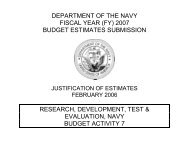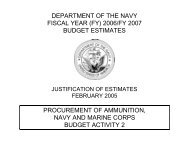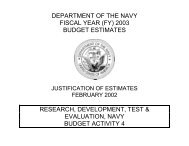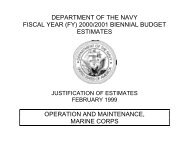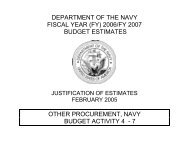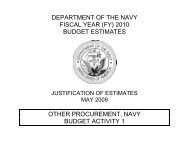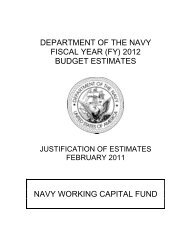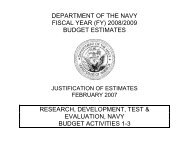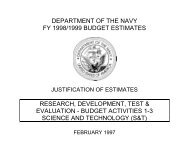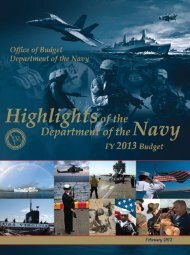Budget Highlights Book - DON FM&C Website - U.S. Navy
Budget Highlights Book - DON FM&C Website - U.S. Navy
Budget Highlights Book - DON FM&C Website - U.S. Navy
Create successful ePaper yourself
Turn your PDF publications into a flip-book with our unique Google optimized e-Paper software.
February 2010Rebalancing Investment to Meet Global RequirementsThe RQ‐7 MCTUAS was procured through jointefforts with the Army’s Shadow program. The lasteleven air vehicles were procured in FY 2010 withTactical Common Data Link (TCDL) modificationscontinuing in FY 2011. The Shadow UAS is providing Marine Tier III UAScapability to the MAGTF commander, while replacing the legacy Pioneer UAS. TheRQ‐7 Shadow UAS is interoperable, compatible, and maintainable with ArmyShadow units.The STUAS is a combined <strong>Navy</strong> and Marine Corpsprogram for a common solution that providesPersistent Intelligence, Surveillance, andReconnaissance/Target Acquisition (ISR/TA)support for tactical level maneuver decisions andunit level force defense/force protection for navalamphibious assault ships (multi‐ship classes) and<strong>Navy</strong> and Marine land forces. FY 2011 is the initial procurement of 18 air vehicles.STUAS has a planned IOC of FY 2012 and will be used to complement other highdemand, low density (HDLD) manned and unmanned platforms. STUAS will beavailable to operate from ship/shore scenarios where those HDLD assets may not beavailable to ship or other <strong>Navy</strong> unit commanders. This system will fill the ISRcapability shortfalls currently filled by the ISR services contracts.RQ‐4 BAMS system development and demonstrationcontinues in FY 2011 with $529 million to provide aHigh Altitude‐Long Endurance Unmanned AircraftSystem designed to provide persistent maritime ISR ofnearly all the worldʹs high‐density sea‐lanes, littorals,and areas of national interest. Envisioned as anunmanned adjunct to the P‐8A Multi‐Mission MaritimeAircraft (MMA), and crucial to the recapitalization of<strong>Navy</strong>ʹs airborne maritime ISR capability, the systemwill seek to leverage Maritime Patrol and Reconnaissance Force (MPRF) manpower,training and maintenance efficiencies. The BAMS UAS air vehicle features sensorsdesigned to provide near worldwide coverage through a network of five CONUSand OCONUS orbits, with sufficient air vehicles to remain airborne for 24 hours aday, 7 days a week, out to ranges of 2000 nautical miles. Onboard sensors willprovide detection, classification, tracking and identification of maritime targets andFY 2011 Department of the <strong>Navy</strong> <strong>Budget</strong> 5–13



